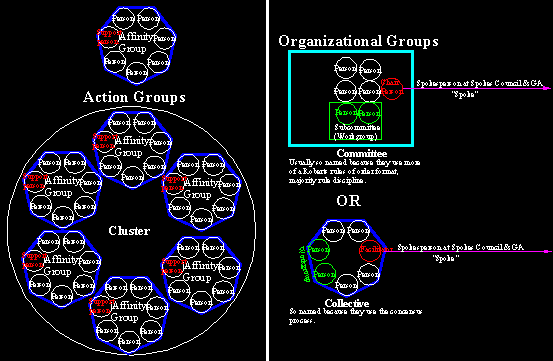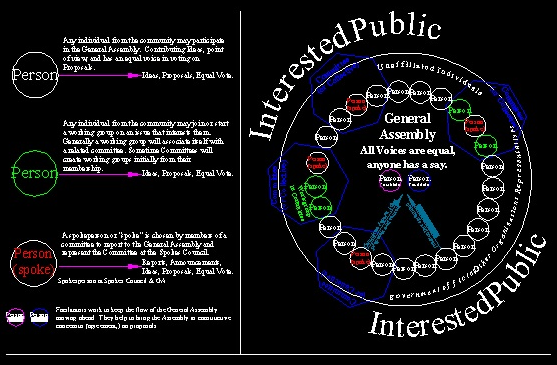
Occupy San Luis Obispo County Information
we become silent about things that matter."
Martin Luther King Jr.
The General Assembly is the "leader" in what has been called "a leaderless" movement. The members of the General Assembly are any members of the 99% of the public that attends the meeting.
Naturally as problems are brought out and issues identified some members of the General Assembly will want to work on them, or take some action in regard to the problems and issues. People with the time, energy and interest to do so will form a 'working group' toward that end. If the working group is working on an issue or task that easily places it within the activity sphere of an existing committee then the working group will generally be placed into that committee by the general assembly and reports back to the General Assembly will be made through that Committee spokesperson (spoke.)
If the working group does not fit within any existing Committee then it may continue its activity for some time as a working group, reporting just after Committee reports at the General Assembly if need be. It may over time be designated a Committee by the General Assembly.
The General Assembly meeting itself will have a structure, and this varies from locale to locale. At a General Assembly there will be a time for Committee Reports, a time for announcements, a time for discussion and, a time for proposals .
At this General Assembly there are two segments of time usually allotted for introducing proposals that are not on the Agenda. One is for urgent matters, and Proposals brought up by Committees just after Committee and working group reports. The other time segment is near the end of the General Assembly when the Assembly opens itself up for any other items not on the Agenda.
Anyone can bring a proposal to the General Assembly.Groups and Structure Terms
 The Structure shown here was used by the anti-nuclear movement and has some merit.
The Structure shown here was used by the anti-nuclear movement and has some merit.
Affinity Groups: Are groups of individuals (usually 3 to 15 or so) committed to work together in a direct action. They form themselves in the Community of their own accord. The members of an Affinity Group are encouraged to go through non-violence training together as it 'tightens the bond' of the group to do so. Affinity Groups are autonomous and should provide for their own support if needed. The larger the Affinity Group, the more support people it usually needs.
The "Support person(s)" act to support the group, they provide transport or supplies and communications with the outside world, to help sustain the Affinity Group while they are actively doing their Direct Action. They are also the "observors" looking out for the individuals in the group. The importance of the support person can be profound for groups doing non-violent civil disobedience. The individuals involved know they have someone looking out for them, and this can give a person more confidence during tense moments that sometimes occur during Direct Actions.
If an Affinity Group intends to do non-violent civil disobedience(CD) it is of particular importance that the Support Person in the group be outside the action zone (not subject to arrest.) This person(s) will act as the anchor for the group. This person will be the groups contact in the outside world while the rest of the group is doing their CD, and also when the group is in jail. They can act as the phone # to call, and bring things needed to the jail as well as visit to help keep up morale of the group. They also keep watch on the treatment of their group during the arrest if possible, and while in jail helping to assure that people are treated fairly by the legal system. They also act toi call in local resources (from appropriate local agencies or organizations) to help if something is amiss.
Clusters: Some Direct Action is more effective when a some minimum number of people participate. For Planned Direct Actions it may be that the Direct Action Committee will ask that Affinity Groups hold off doing their Direct Action until some requisite (effective) number of Affinity Groups want to participate in it.
Generally an Affinity Group that initially proposes to do some Direct Action is brought into the Direct Action Committees process to help determine what number of Affinity Groups would be most effective. Sometimes they decide to go ahead alone, but often they like the idea of doing it with a larger number of people.
Once the effective Cluster Size (# of Affinity Groups,) is agreed upon that number is used as a target that everyone aims for.Some affinity groups involved in civil disobedience in which they expect to be arrested get clever about naming themselves. One such group was "Waging Peace" and another was "Life on Planet Earth" The court case names end up being in re: "The People of the United States vs Waging Peace" or "The People of the State of California vs Life on Planet Earth" which can be a morale booster while going through the court process.


